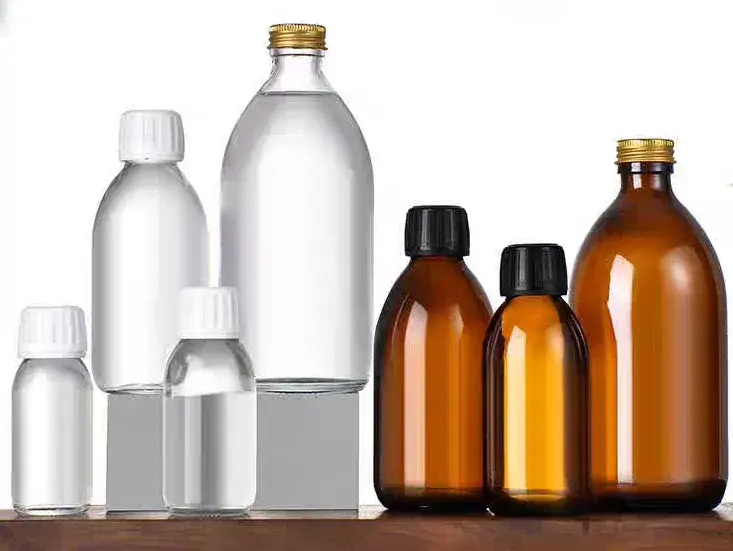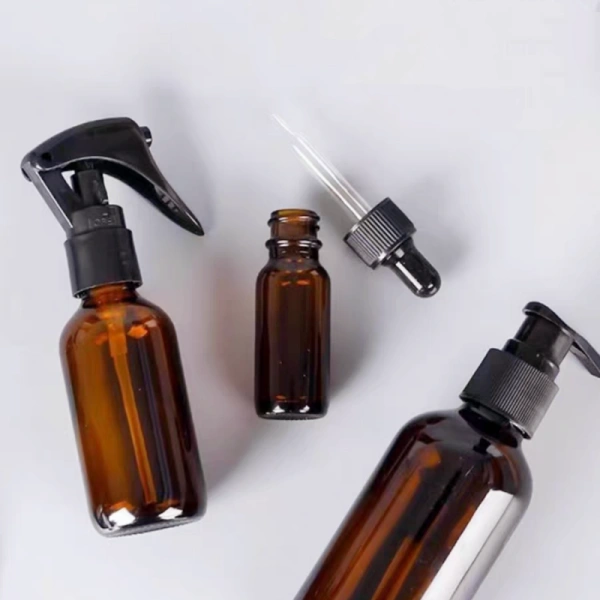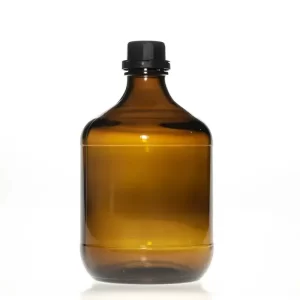When you see a product packaged in an amber glass bottle, do you ever wonder why? Is it just a stylistic choice, or is there more to it? As someone who has been manufacturing glass containers for over a decade, I can tell you it's a decision rooted deeply in science. The rich, dark color of amber glass isn't merely for aesthetics; it's a functional feature designed to protect the contents and preserve their integrity.
This article will pull back the curtain on the science behind amber glass bottles. We'll explore how they are made, why they are the gold standard for UV protection, and which industries depend on their unique properties. For business owners and procurement managers, understanding this science is key to making informed packaging choices that safeguard product quality, extend shelf life, and ultimately protect your brand's reputation. Let's dive into why this humble glass bottle is a powerhouse of preservation.
What Exactly Is Amber Glass and How Is It Made?
Before we can appreciate its protective qualities, it helps to have a basic understanding of how glass is made. At its core, all glass starts with a few simple, natural ingredients: sand (silica), soda ash (sodium carbonate), and limestone (calcium carbonate). These materials are heated to extremely high temperatures (around 1700°C or 3090°F) until they become a glowing, honey-like molten liquid. This liquid glass is then ready to be shaped.
To create amber glass, a few specific ingredients are added to this molten mixture. The iconic amber color is achieved through the precise addition of various metals and minerals, primarily sulfur, iron, and carbon to the molten mixture. When these elements are introduced into the furnace under specific conditions, they react to form iron polysulfides. These compounds are what give amber glass its well-known hue and, more importantly, its powerful light-filtering capabilities. The intensity of the amber tint can be controlled by adjusting the quantity of these ingredients and the furnace conditions, a process we have perfected on our production lines. So, in short, amber glass is made through a carefully controlled chemical recipe.
Why Is UV Protection So Crucial for Stored Products?
You've heard that UV light is bad for your skin, but it's just as damaging to a wide range of consumer products. Ultraviolet (UV) light is a form of electromagnetic radiation with a wavelength shorter than visible light but longer than X-rays. Because it's invisible to the human eye, its degrading effects can go unnoticed until the damage is already done. This process, known as photodegradation, is a chemical alteration that can ruin a product's potency, color, aroma, and flavor.
Consider the pharmaceutical industry. The active ingredients in many types of medicine are delicate organic compounds. When exposed to UV rays, these compounds can break down, rendering the medication ineffective or even harmful. The same is true for essential oils, where UV exposure can destroy the volatile aromatic compounds that give them their signature scents and therapeutic properties. In the beverage world, this is most famously seen in beer. Exposure to light triggers a reaction with hop compounds, creating a substance chemically similar to a skunk's spray—this is why beer in clear glass often tastes "skunked." The harmful effects of light directly impact shelf life, making UV protection a non-negotiable for many stored products.
How Does Amber Glass Provide Superior UV Protection?
This brings us to the core of the science behind amber glass. Its effectiveness lies in its remarkable ability to absorb light. The iron polysulfides formed during the manufacturing process act as a powerful light filter. The properties of amber glass are such that it absorbs almost all radiation with a wavelength shorter than 450 nm.
Why is this 450 nm cutoff so important? The ultraviolet spectrum ranges from approximately 100 nm to 400 nm. By blocking everything below 450 nm, amber glass effectively provides a near-total barrier against the entire UV spectrum—UVA, UVB, and UVC. This is how amber glass protects the contents from light so efficiently. Unlike coatings or films that can wear off, this protection is inherent to the glass itself, providing permanent and reliable uv protection. This is the fundamental reason why the use of amber glass is so prevalent for light-sensitive products.

Does Amber Glass Block Other Types of Light, Like Blue Light?
The benefits don't stop at UV light. The 450 nm cutoff point means that amber glass also blocks blue light and violet light, which are part of the visible light spectrum (roughly 400-495 nm). While not as high-energy as UV light, blue light can also contribute significantly to product degradation, a fact that is often overlooked when considering packaging.
The most classic example, again, is beer. Scientific studies have shown that the "skunking" reaction is most aggressively triggered by light in the blue-violet spectrum. By blocking this range, an amber glass bottle provides a secondary layer of defense that green or clear glass simply cannot match. This dual protection against both UV and blue light is what makes amber glass the undisputed champion for preserving the quality and flavor of beer and many other light-sensitive beverages and formulations. Its ability to block this portion of the spectrum is a key aspect of the unique properties of amber glass.
What Are the Primary Benefits of Using Amber Glass Containers?
When you choose amber glass for your packaging, you are leveraging a material with a host of advantages. We've talked at length about light protection, but there are many benefits of amber glass that make it a superior choice, especially when compared to alternatives like plastic.
Here are the key benefits:
- Unmatched Light Protection: As discussed, it provides a comprehensive shield against damaging UV and blue light, preserving product integrity and extending shelf life.
- Chemically Inert and Pure: Glass is non-porous and impermeable. It will not react with the contents or leach chemicals, ensuring the product remains pure and untainted. This is a stark contrast to some plastic bottles, which can pose a risk of chemical leaching over time.
- Environmentally Sustainable: Amber glass is made from natural materials and is 100% recyclable without any loss of quality. It can be melted down and reformed into new glass products infinitely, making it a responsible choice from an environmental science perspective.
- Premium Look and Feel: An amber glass bottle conveys a sense of quality, stability, and professionalism. For consumers, it often signals a high-quality, natural, or pharmaceutical-grade product.
These combined factors make amber glass containers an excellent choice for a variety of applications. It's not just a container; it's an active part of your product's formulation, working to keep it safe and effective from the factory to the consumer's hands.
Which Industries Rely Most on the Use of Amber Glass?
The exceptional protective properties of amber glass make it indispensable across several key industries. You'll find amber glass bottles and jugs are the standard in any field where product stability is paramount.
-
Pharmaceuticals and Medicine: This is perhaps the most critical use of amber glass. From prescription cough syrups and liquid vitamins to tinctures and homeopathic remedies, amber glass bottles ensure that the active ingredients remain stable and potent. You will often see medicine packaged in
amber glass vialsand bottles to protect it from photodegradation. -
Cosmetics and Wellness: The wellness boom has seen a surge in products containing essential oils, natural extracts, and complex serums. These delicate and often expensive ingredients are highly susceptible to light damage. High-quality amber glass bottles, particularly Boston rounds with droppers, are the preferred choice for protecting these formulations.

-
Food and Beverage: The craft beer industry relies almost exclusively on amber glass to prevent "skunking." It's also the choice for storing many specialty oils, kombuchas, and cold-brew coffees, where preserving the complex flavor profile is essential. Larger amber glass jugs are often used for bulk or growler applications.
-
Cannabis Industry: As the legal cannabis market matures, producers are adopting pharmaceutical-grade packaging standards. Amber glass is ideal for protecting CBD and THC oils, tinctures, and terpenes from degradation. Child-resistant amber glass jars are also becoming the standard for storing dry flower, preserving its potency and aroma.
Is Amber Glass Toxic or Unsafe in Any Way?
A common question we receive from new clients is, "is amber glass toxic?" The answer is a resounding no. Amber glass is one of the safest and most non-reactive packaging materials available. Its safety stems directly from its composition and the manufacturing process.
As we've covered, glass is made from natural materials like sand. The coloring agents—sulfur, iron, and carbon—are not just mixed in; they are chemically bonded within the glass's molecular structure during the molten phase. This means they are completely inert and cannot leach out into the product, even with highly acidic or alkaline contents. Amber glass is fully compliant with FDA regulations for food and drug contact, making it a trusted material for everything from baby medicine to beer. Unlike some plastics, there is no risk of BPAs or other harmful compounds contaminating your product. When you use amber glass, you are choosing purity.
How Does Amber Glass Compare to Clear and Other Colored Glass?
While amber glass is a top performer, other types of glass are used for packaging. How do they stack up? Understanding the differences is crucial for making the right choice for your specific product. While other colored glass bottles offer some protection, they are not all created equal.
Here is a simple comparison:
| Glass Type | UV Protection Level | Common Uses | Notes |
|---|---|---|---|
| Amber Glass | Excellent | Pharmaceuticals, Beer, Essential Oils, Chemicals | The industry standard for light-sensitive products. It offers the best uv protection. |
| Cobalt Blue | Good | Decorative, Water, Some Cosmetics | Blocks some UV but is less effective than amber glass. It's often a stylistic choice. |
| Emerald Green | Fair | Wine, Some food oils | Offers some protection, traditionally used for wine. It's better than clear glass but inferior to amber. |
| Clear Glass | None | Food, Beverages, Cosmetics (non-sensitive) | Offers no UV protection. Used when product visibility is the top priority and the contents are stable. |
As the table shows, while blue and green glass provide a degree of protection, amber glass is the clear scientific winner for products that are highly sensitive to light. The decision to choose amber glass is a decision to prioritize preservation over simple visibility. For many products, what's inside is too valuable to leave exposed.

What Should You Look for in a High-Quality Amber Glass Bottle Supplier?
I'm Allen, and I run a factory with seven production lines dedicated to making high-quality glass jars and containers. Over the years, I've worked with hundreds of business owners and procurement officers. I understand that choosing a supplier is about more than just price; it's about finding a reliable partner who can help you navigate the complexities of sourcing. The science behind amber glass is fascinating, but it means nothing if the glass bottle itself is flawed.
Based on my experience, here’s what you should demand from a supplier:
- Verified Quality & Certifications: A trustworthy supplier doesn’t just claim quality; they prove it. They should readily provide inspection reports, material specifications, and valid, unexpired certifications (like ISO 9001 or child-resistance compliance). Be wary of anyone who is hesitant or provides dubious documents. We pride ourselves on transparency and stand behind our glass products with comprehensive documentation because we know our high-quality amber glass meets the standards.
- Clear Communication & Technical Support: You need a partner who understands your business needs, not just an order-taker. A good sales representative should be able to explain the technical details—like why a certain type of amber Boston bottle is better for your serum—in a way that is easy to understand. This prevents costly mistakes and ensures you get the perfect package for your product.
- Proven Logistical Expertise: As many buyers know, shipping delays can derail a product launch. An experienced supplier has a deep understanding of international logistics, from secure packaging methods that prevent breakage to navigating customs for smooth clearance. Having shipped millions of amber glass bottles to the USA, Europe, and Australia, we've refined our process to be as efficient and reliable as possible.
Choosing a supplier is a partnership. You need a company that is invested in your success. When you find a manufacturer who delivers on quality, communication, and reliability, you're not just buying a glass bottle; you're securing your brand's future.
The Future of Amber Glass: Innovations and Sustainability
Even with a history stretching back over a century, amber glass is still a material of the future. Its core benefit—unbeatable UV protection—is timeless. However, the industry is not standing still. The primary driver of innovation today is sustainability. As a 100% recyclable material, glass is already a leader in environmental science, but we are constantly pushing to do better.
Innovations like lightweighting are making amber glass bottles stronger while using less material, which reduces transportation costs and carbon footprint. Advanced manufacturing techniques are allowing for more intricate and unique shapes, giving brands new ways to stand out on the shelf, which is a key interest for designers and decorators. Furthermore, the development of new closure systems and dispensing options continues to expand the versatility and use of amber glass. The combination of its scientifically proven protective qualities and its strong environmental credentials ensures that amber glass will remain the packaging material of choice for discerning brands for years to come.
Key Takeaways to Remember
- Scientific Creation: Amber glass is made by adding carbon, sulfur, and iron to molten glass, creating a material that is inherently protective.
- Superior Light Filtering: Its primary function is to block virtually all UV light and blue light with a wavelength below 450 nm, making it the best choice for light-sensitive products.
- Preserves Quality: This protection is vital for extending the shelf life and maintaining the potency, flavor, and color of products in the pharmaceutical, cosmetic, food, and beverage industries.
- Safe and Sustainable: Amber glass is non-toxic, chemically inert, and will not leach into your product. It is also 100% and infinitely recyclable.
- Choose Your Partner Wisely: When sourcing an amber glass bottle, look for a supplier who provides verified quality, clear communication, and proven logistical expertise to ensure your product is protected from creation to consumer.
Post time: 06-25-2025







